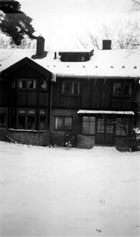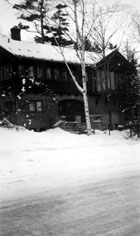 |
firm active: 1907-1921 minneapolis, minnesota :: chicago, illinois |
Residence and Studio for Paul Mueller
Purcell, Feick and Elmslie
Minneapolis, Minnesota 1910
Text by William Gray Purcell
Parabiographies entry, Volume for 1910
Job Date (in Parabiographies): December 13, 1910
PAUL MUELLER
Paul came barging into our office with his bride, both of them all togged out in their trousseaux, and announced that he was setting up a professional practice in landscape architecture. A year later he asked us to plan his house and office. Mr. Elmslie developed the entire project according to his own views, and a charming and successful building it was.
We made some studies for his dwelling, but by the time he was ready to build, although not dissatisfied with his office building, Mueller had run off with the idea of honesty in construction and architecture, which we had been preaching to him. His rather materialistic and definitely constructivist interpretation of this philosophy fixed his determination to build "a genuine English half-timber home," using solid mortised timbers, the panels between filled in with brick masonry in patterns, all in the old-fashioned way. That this was hardly related to either the economics or the spiritual content of our times and, indeed, is not a very good weather resisting form of construction, Mr. Mueller did not discover until he had completed the building and found it to have cost two or three times what it should have cost. Saddest of all, it turned out just an ordinary house, and as always in design by borrowed forms, the dwelling spoke with none of the charm and grace which Mueller had expected would arrive from Elizabethan England, along with the form of construction and gadgets of design which he had adopted.
The Charm Fled, to England Back
Nor could the homes which had bloomed in the soft sweet meadows of Elizabethan England expect to be happy in a bustling American town where the winters were sealed in deep snow and seasoned with zero temperatures. Mueller had considerable money behind him, so the cost did not matter, and a new house always carries a full measure of excitement to make up for a time for the absence of more enduring satisfactions. About 1916, he pulled up stakes and moved to Chicago, where he took offices in the Peoples Gas Building, on the floor below ours.The following images of the Tudor revival house discussed in this Parabiographies entry are from the University of Minnesota Libraries UMedia Archives web site.

Collection: William Gray Purcell Papers, Northwest Architectural Archives, University of Minnesota [AR:B4d1.4]
